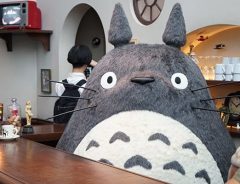
Source: Morio, CC BY-SA 3.0, via Wikimedia Commons
Shinjuku: the humble beginnings of Tokyo’s most dynamic sub-city
Related Article
-

MUJI Created A Stunning Model Of Tokyo With 10,000 Of Their Products
-

Feel The Autumn In The Middle Of Tokyo – A Great Spot For A Romantic Date Too!
-

My Neighbor Totoro Has A Sequel That A Lot Of People Don’t Know About
-

Experience The Working Life Of A Manga Artist At This Japanese Cafe
-

Tokyo’s Kirby Cafe Reveal New Menu of Awesome Dishes for Chapter 2
-

A feline Hachiko? Café meetup rendezvous opens below Shinjuku’s giant 3-D cat


Rather than a city with a centre, it is more helpful to think of Tokyo as a ring, with at least five sub-cities dotted on it. Of these, the liveliest, most dynamic, and most representative has to be Shinjuku.
Standing outside the biggest train station in the world, taking in the plethora of department stores, boutiques, eateries, and drinking holes, it's easy to forget that until the late 19th century, Shinjuku was little more than a village.
Shinjuku got its start in the Edo era (1603-1868). The starting point of all things in the city of Edo was the Low City, more specifically Nihonbashi 日本橋. From there, the shogunate had five roads built to take its tax inspectors into the provinces.
The road that led west into the High City, through the villages of Yotsuya 四ッ谷 and Ushigome 牛込 and across the Musashino Plain 武蔵野平原 to Kai Province 甲斐の国 (today's Yamanashi Prefecture), was called the Kōshū Kaidō 甲州街道. The first post station on this road was Takaido 高井戸. Because it was 15 km from Nihonbashi, a local man by the name of Kihei Takamatsu 高松喜兵衛 asked the shogun if he might build a post station in the reeds midway between the two.
This was the Naitō Shinjuku 内藤新宿 post station, named after the feudal lord who owned the land on which it was built in 1698. It doubled up as a jishin ban'ya (自身番室), the forerunner of today's police stations and kōban. This was where the tools needed to put down riots, capture offenders and fight fires was kept. It also functioned as a holding cell, assembly hall and administrative office, a place where decrees were copied, and public officials met.
Jishin ban'ya were run by landlords, hence the name, which means something like 'oneself police station.' Property owners and their servants took turns on duty and other local people supplied horses and manpower, with the cost being born by the property owners.
A scale model of Naitō Shinjuku in the Shinjuku Historical Museum. | ja:User:Tdk, CC BY-SA 3.0, via Wikimedia Commons
A straggle of inns sprang up around the Naitō Shinjuku post station. It became known as a collection point for nightsoil and horse manure, which was carried out to fertilise the surrounding farmland. From the middle of the Edo period, the fields around Shinjuku became a source of vegetables for the rest of the city, with the Naitō red chili pepper 内藤とうがらし, Naruko melon 鳴子ウリ and Waseda myoga ginger 早稲田ミョウガ being especially prized.
Shinjuku wasn't without its charms, however. People came to enjoy cherry blossom viewing on the Tama River 多摩川 in spring, the fireflies in Ochiai 落合 in summer, and the snowscape at Omokagebashi 面影橋 in winter. But it was best known for its horse manure, clouds of which would blow up on windy days. When the woodcut printer and artist Utagawa Hiroshige 歌川広重 depicted Shinjuku in One Hundred Famous Views of Edo 名所江戸百景 in 1857, he chose to put a packhorse's rear end and its dung in the foreground.
Hiroshige's depiction of Naitō Shinjuku. | © Picryl, Public Domain
By the time of the Meiji Restoration in 1868, Shinjuku was still largely empty, bar a handful of estates belonging to feudal lords. With the change of government, unused lands in the High City were confiscated and turned over to agriculture. There were 100 acres of tea and mulberry plantations in Akasaka 赤坂 at one time and Shibuya 渋谷 became known for its excellent tea.
Shinjuku station was built in 1885, a small station with few passengers. Shinjuku only really urbanised in the Taisho era (1912-1926). As late as 1907, when the popular writer Tokutomi Roka 徳冨蘆花 decided that he wanted to emulate his hero, Leo Tolstoy, and live on the land, he only had to travel six miles west from Shinjuku to be among peasants.
Most of Tokyo was destroyed by the fires that followed Great Kanto earthquake of 1923, but the city rebounded quickly. The quake sped up the process by which its centre of gravity shifted from the Low City to the High City. After 1923, anyone with any wealth or power in Nihonbashi, Asakusa 浅草 and Honjo 本所 moved west.
Unlike most of the High City, Shinjuku was heavily damaged by the quake, but it was soon re-populated in the aftermath. Mitsukoshi 三越 opened several emergency markets in Tokyo, and its Shinjuku market went on to become the area’s first department store.
By 1925, Shinjuku’s new station was complete, and railway lines were laid out on the Musashino Plain to carry a new generation of office workers from their homes in the new western suburbs to their workplaces in Marunouchi 丸の内. These salarymen lived in bunka jūtaku 文化住宅 (cultured houses), which incorporated western elements like a reception room and a small entrance hall into the traditional Japanese home.
This new class of white-collar workers went to Shinjuku to eat, drink and shop, and by 1930, it had become the second-biggest retail district in the city after Ginza. They had a formative impact, for they tended to be less plebian, more open, and more critical than the Edo-kko (those who had lived in Tokyo for at least three generations), who can still be found in Shitamachi 下町 neighbourhoods like Ueno 上野 and Asakusa.
As the High City flourished, the Low City gradually began to lose its dynamism, and became conservative, even stodgy. Class distinctions tended to blur in the Low City, partly because anyone with any money had moved west, and partly because the old-timers were united by their conservatism.
Even in fresher neighbourhoods like Shinjuku, the gap between rich and poor yawned until the post-war years, however. There was a slum in Shinjuku just south of the station, a place of cheap inns, bed bugs, and a transient population of day labourers, peddlers, street musicians, and hawkers. There was also a licensed pleasure quarter, one of six in the city.
Universities moved west too, and with them went the intellectual and bohemian types, who settled around stations on the Chūō line like Nakano 中野, Kōenji 高円寺, and Kichijōji 吉祥寺. Since Waseda University was nearby, Shinjuku attracted students, among them the ‘Marx boys,’ and it became a centre for the new leftist intelligentsia in the '30s.
These people made Shinjuku a lively place. Customers flocked to places like the Takano Fruit Parlour and Nakamuraya's curry house (which claims to be the birthplace of curry rice). Isetan joined Mitsukoshi as a shopping destination, making Shinjuku a rival to Ginza for the affections of the discerning housewife.
This all came to an eye in the militarist period and the war that followed. The bombing raids grew more intense from November 1944 and were particularly bad in April and May 1945. Most of Shinjuku was burned to the ground. The story of how it recovered and went on to become the king of Tokyo's sub-cities is one for another time.